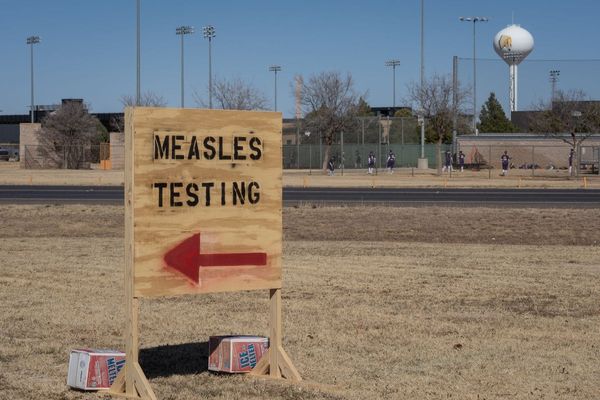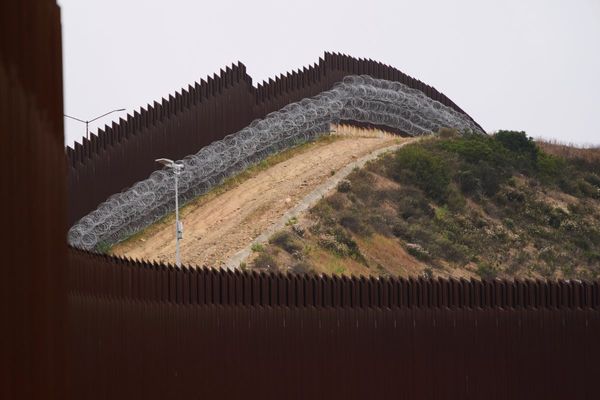
Kate Selby Smith strides through the undergrowth of a track on the North Island’s east coast when the bush suddenly thins to reveal a hidden treasure. “Welcome to my heaven,” she says, gesturing to a bend in the Wharekirauponga stream where a jade-green swimming hole has formed among the rocks and soft green ferns. “Isn’t it beautiful?”
The fairytale grotto lies at the southern end of Coromandel forest park – a protected conservation area home to native flora and rare animals, including one of the world’s rarest amphibians, the Archey’s frog.
Like other locals, Selby Smith brings her family to the pool to swim and explore. But she worries for its future. Further up the valley lies another kind of treasure that has attracted the interest of the government and a multibillion-dollar mining company: gold.
New Zealand is embarking on a major mining expansion. A controversial new fast-track law is pushing through projects designed to spur economic growth, alarming groups who say the country’s unique biodiversity and natural resources are under threat.
“That legislation is egregiously damaging … for New Zealand’s environment,” says Gary Taylor, the chief executive of the Environmental Defence Society.
“It’s heavily stacked against the environment and in favour of development – in all my years of working as an environmental advocate, I’ve never seen anything like it.”
For many living in New Zealand – where a deep connection to nature is regularly cited as being an important part of personal and collective identities – the mining strategy undermines a path towards a greener future. They argue it also runs counter to New Zealand’s self-image as a wild and pristine place. The country famously promotes itself to the world as “100% pure” and “clean, green”. Yet to others, the law represents a much-needed boost to the economy. The Minerals Council chief executive, Josie Vidal, says mining is “one of the most productive sectors in New Zealand, which translates into high wages”.
Zombie projects reawaken
The rightwing coalition government has promised to restart offshore oil and last week set aside $200m of its budget to invest in gas exploration. It plans to boost mineral exports to $3bn by 2035, at the same time it has slashed funding to conservation and climate initiatives. It has also proposed a law change to make it easier for companies to kill protected wildlife in order to pursue certain infrastructure projects. The direction marked a departure from the Jacinda Ardern-led government, which banned new offshore oil and gas exploration and promised to ban new mines on conservation land.
The coalition’s fast-track law – a “one-stop shop” for infrastructure and mining projects deemed nationally significant – passed into law in 2024 amid anger that it bypasses environmental regulations, shuts out public consultation and throws a lifeline to so-called zombie projects that have been rejected in the courts and languishing for years. The government says the process will include a description of the project’s impacts on the environment, which the decision-making panel must consider.
Nearly 150 projects are moving through the fast-track process, including 11 gold, mineral sands and coalmining proposals. They include new mines and expansions to existing projects. Some are generating controversy, including a plan to mine iron sands off Taranaki’s seabed previously rejected by the supreme court, and two mines in the South Island’s west coast: a goldmine critics fear will threaten rare birds, and a coalmine on ecologically significant land.
The fight for Waihi
The fast-track law prompted thousands to march in protest in 2024 and nearly 30,000 public submissions on the bill. Now, targeted protests are springing up around some of the proposed mining sites, including in Selby Smith’s beloved Coromandel area.
Mining company OceanaGold is hoping to dig a nearly 7km tunnel 200 metres beneath the Wharekirauponga forest in Coromandel, which forms part of a large conservation estate, to mine roughly 34-45 tonnes of gold worth about $5bn.
The project is an expansion of the company’s existing operations in the nearby historic goldmining town of Waihi and will also include a new open-pit mine, increased storage for tailings – a slurry of ground-up rock that contains oxidised minerals and cyanide – and upgraded infrastructure.
Local environment group Coromandel Watchdog – of which Selby Smith is a member – opposes the proposal and has led multiple protest actions against it.
The group worries that underground mining blasts will affect Archey’s frogs, who sense the world through vibrations. It is also concerned that water-dredging and rock crushing could reshape the underground water systems and release pollutants that could spread downstream, and tailings storage will leave a toxic legacy for future generations.
OceanaGold rejects these concerns, saying the project will be a “win-win”.
Alison Paul, the miner’s manager for legal and corporate affairs, says “the right projects in the right place can ultimately achieve both the protection of [the] environment and economic growth”.
Paul says OceanaGold’s modelling shows vibrations from blasting will have a limited impact on the frogs, and the company’s 600-hectare pest-control programme in the amphibian’s habitat will give back to the conservation estate. Sucking out underground water to stop the mine flooding will do little damage to the natural waterways, she says, adding that should high risks develop, the company could stop its project.
The tailings dams, she says, are highly engineered to withstand the forces of nature for generations to come. Furthermore, the project will bring jobs to the region and produce export income for New Zealand, Paul says.
‘More species extinctions’
Nearly 1,000km away from Waihi, on the west coast of the South Island, another battle is playing out over Bathurst Resources’ proposal to extract an extra 20m tonnes of coal from the Buller plateau over the next 25 years.
As in Waihi, the proposal’s advocates say it will create jobs and financial growth, while critics worry it will damage the ecologically significant area that is home to rare native species and contribute to climate change.
Up the coast, in the North Island, the Taranaki community has spent more than a decade trying to stop Australian company Trans-Tasman Resources from mining 50m tonnes of iron sands from the seabed, while in the far north, Bream Bay locals are hoping to halt a project to dredge more than 8m cubic metres of sand for concrete production.
But these communities may struggle to find a sympathetic ear in the government.
New Zealand’s mining push is being led by the resources minister, Shane Jones, an ardent advocate for extractive industry who wears caps emblazoned with “Make NZ Great Again, drill baby drill” and once told parliament that “if there is a mining opportunity and it’s impeded by a blind frog, goodbye Freddy”.
“Over the last 10 to 15 years the extractive sector has been marginalised and become an ideological plaything,” Jones told the Guardian. “[For] those people who have sought to deify our wilderness … those days are over.
“We cannot afford to maintain that level of naivety in the face of major geopolitical challenges [and] threats to our national resilience.”
New Zealand’s economy suffered as a result of the Covid-19 pandemic. The country experienced the biggest contraction in GDP of any developed country in the world in 2024, due to high interest rates and unemployment.
Rebuilding the economy is top of the government’s agenda and Jones believes boosting the mining sector will create jobs, attract New Zealanders back to the country and generate GST and export royalties – though he concedes his $3bn by 2035 figure is aspirational.
Martin Brook, a professor of applied geology at the University of Auckland, says mining will create well-paid jobs, feed minerals into global supply chains and leave a “tiny” footprint.
“If any country globally can extract minerals effectively with as little environmental footprint as possible, it is New Zealand,” he says.
New Zealand’s unique natural environment evolved in the absence of people and predators, creating a high level of endemism. However, its species are in worrying decline, with a high proportion threatened, or at risk of extinction – one of the highest amid the global biodiversity crisis. Many of the country’s fresh waterways are in a dire state, contaminated by thousands of sewage overflows, flooded with nutrient pollution from farming and blooming with toxic algae.
“It’s a very fragile place,” Taylor says, adding he is concerned the stringent environmental tests that have been placed on mining companies are being whittled away through the fast-track process.
“Our environment could go materially and substantially backwards – more species extinctions, more stuffed-up landscapes, poorer freshwater quality,” Taylor says.
Meanwhile, the economic benefits from mining are not certain, says Glenn Banks, a geography professor at Massey University. Fluctuating prices and demand for minerals, as well as challenges in taxing and securing foreign investment make the industry volatile.
“You get a lot of cowboys jump in on the boom and then walk away when prices aren’t good,” Banks says.
Back in the Wharekirauponga bush, Selby Smith pauses to reflect on the landscape around her.
“This is the crux of it: there are so few of these places left,” she says. “If this becomes polluted from mining waste – what will we give to our children?”







